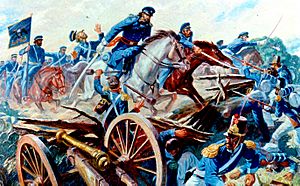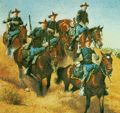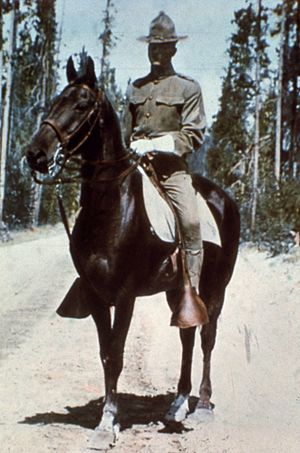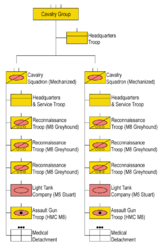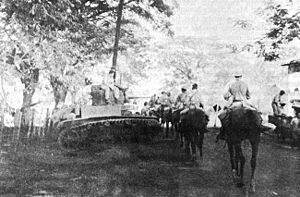United States Cavalry facts for kids
Quick facts for kids United States Cavalry |
|
|---|---|

Cavalry branch plaque
|
|
| Active | 1775–1950 |
| Country | |
| Branch | |
| Type | Cavalry |
| Role | Reconnaissance, security (e.g., flank screening, advance guard, rear guard, combat out post, etc.), and economy of force missions |
| Patron | Saint George |
| Insignia | |
| Branch insignia | 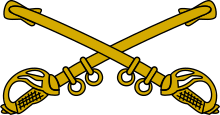 |
The United States Cavalry, or U.S. Cavalry, was a special part of the United States Army. It was made up of soldiers who rode horses. The U.S. Congress officially created this group on August 3, 1861. This act combined different types of mounted soldiers, like dragoons and mounted riflemen, into one cavalry branch.
Over time, the cavalry changed. In 1940, it started using tanks and became part of the Armored Forces. Even today, the word "cavalry" is still used in the U.S. Army. It refers to units that do reconnaissance, which means they scout ahead and gather information. This includes both ground units and those that use aircraft. The famous 1st Cavalry Division also keeps the name for historical reasons.
After the Mexican–American War (1846–1848), the United States gained a lot of new land. The government wanted to open this huge area for people to settle. This land, especially between the Missouri River and California, was home to strong Native American tribes. To protect new settlers, soldiers needed to patrol this vast area. In 1855, Congress added the 1st and 2nd Cavalry regiments to the U.S. Army to help with this task.
Before 1833, mounted troops were only formed when there was an emergency and then disbanded. But in 1833, Congress created the 1st U.S. Dragoons. The 2nd U.S. Dragoons and U.S. Mounted Riflemen followed later. The U.S. Cavalry's traditions came from horse-mounted forces used during the American Revolutionary War. After the American Civil War (1861–1865), horse cavalry was very important for controlling the huge Western United States. They covered long distances between small, isolated forts with limited resources.
Horse-mounted units also fought in later wars, like the Spanish–American War in 1898 and World War I (1917–1918) in Europe. However, their numbers and roles began to decrease.
Right before World War II (1941–1945), the U.S. Cavalry started to switch to machines. During the war, cavalry units used horses, machines, or even fought on foot like infantry. The very last time a U.S. Cavalry unit made a horse charge was in early 1942. This happened on the Bataan Peninsula in the Philippines. The 26th Cavalry Regiment of the Philippine Scouts charged against Japanese forces on January 16, 1942.
In March 1942, the War Department ended the office of Chief of Cavalry. This effectively stopped horse cavalry. The cavalry name was then combined with the Armor branch in 1950. Later, in the Vietnam War, helicopters were used, and units became known as Air Cavalry. Mechanized cavalry units were called Armored Cavalry.
Today, the cavalry name and its traditions continue with both armor and aviation units. These units still carry out the cavalry's original mission of scouting and security. The 1st Cavalry Division is the only active division in the U.S. Army with "cavalry" in its name. This division even has a small group of horse-mounted cavalry for special ceremonies.
History of the Cavalry
George Washington saw how a small group of British cavalry, the 17th Light Dragoons, made his soldiers panic at the Battle of White Plains. He also saw how good Major Elisha Sheldon's 5th Regiment of Connecticut Light Horse Militia was at gathering information. So, Washington asked the Continental Congress for a light cavalry force for the Continental Army. In late 1776, Congress allowed him to create a mounted force of 3,000 men.
Cavalry in the American Revolutionary War
On December 12, 1776, Congress changed Elisha Sheldon's militia into the Regiment of Light Dragoons. In March 1777, Washington created the Corps of Continental Light Dragoons. This group had four regiments, each with 280 men organized into six troops.
The light dragoon regiments faced many challenges. They struggled to find enough soldiers, suitable weapons, and horses. There was also a lack of consistent uniforms and training. Congress brought in experienced soldiers like Michael Kovats from Hungary and Casimir Pulaski from Poland. They trained the dragoons to be an attacking force during the winter of 1777–78 in Trenton, New Jersey.
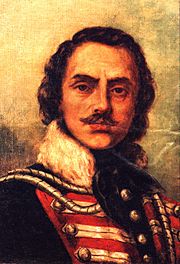
Pulaski's training methods caused some disagreements with American officers, and he eventually resigned. However, Congress allowed Pulaski to form his own independent corps in 1778. Pulaski's Legion included dragoons, riflemen, grenadiers, and infantry. Another independent dragoon corps joined the Continental Army in 1778. This was "Light Horse Harry" Lee's Lee's Corps of Partisan Light Dragoons. This group was good at raiding and disrupting enemy supply lines.
A French nobleman, Colonel Charles Armand Tuffin, marquis de la Rouërie ("Col. Armand"), also formed a third corps in Boston. It was called the Free and Independent Chasseurs and later added a troop of dragoons, becoming Armand's Legion. Even though a reorganization in 1778 allowed for larger regiments, problems like finding enough food for horses, expiring enlistments, and soldiers leaving made it impossible. No regiment ever had more than 200 men, and they usually had between 120 and 180 men from 1778 to 1780.
In 1779, Washington ordered the 2nd and 4th Continental Light Dragoons to fight as infantry for a while. The 1st and 3rd Continental Light Dragoons and Pulaski's Legion were sent south. They joined local militia cavalry to help keep the area American during an unexpected enemy attack. Battles in South Carolina in the spring of 1780 greatly reduced the numbers of the 1st and 3rd Regiments, so they combined into one unit. After Charleston, South Carolina was captured on May 12, 1780, the remaining soldiers tried to regroup in Virginia and North Carolina. In August 1780, Armand's Legion was with General Gates at the terrible Battle of Camden.
The most important battle involving Continental light dragoons was the Battle of Cowpens in January 1781. General Nathanael Greene, the southern commander, reorganized parts of Lee's Legion and the combined 1st and 3rd Light Dragoons. He sent them on raids against British loyalist forces in western Carolina. The dragoons joined General Daniel Morgan's "flying corps" at the Battle of Cowpens. They helped secure a very important victory for the American forces early in the war. Later, the 3rd Legionary Corps took part in Greene's movements across North Carolina. They fought well against Cornwallis's army at Guilford Courthouse.
In January 1781, dragoons officially became "Legionary Corps." This meant they used both mounted and dismounted troops. The mounted dragoons were supported by dismounted dragoons who fought as infantry. This organization lasted until the end of the war. In 1783, the Continental Army was disbanded, and the dragoons were released from service.
Cavalry in the War of 1812
The first cavalry unit formed by the U.S. Congress after the Revolutionary War was a squadron of light dragoons. This happened on March 5, 1792, and it was led by Major Michael Rudolph. Its four troops were assigned to different parts of the Legion of the United States. By 1796, only two troops remained. These combined in 1798 with six new troops to form the Regiment of Light Dragoons. This mounted force did not last long and was ended in 1800. The oldest two troops stayed until June 1802. This meant there were no regular mounted soldiers for the next six years.
In 1798, during a time of tension with France called the Quasi-War, Congress created a "Provisional Army" of 10,000 men. This included twelve infantry regiments and six troops of light dragoons. By March 1799, Congress planned an "Eventual Army" of 30,000 men, with three cavalry regiments. These "armies" only existed on paper, but equipment for 3,000 men and horses was bought and stored.
On April 12, 1808, Congress approved a standing regiment of light dragoons with eight troops. As war approached, Congress approved another regiment of light dragoons on January 11, 1812. These became known as the First and Second United States Dragoons.
In 1813, Secretary of War John Armstrong, Jr. allowed Colonel Richard Mentor Johnson to raise two battalions of volunteer cavalry. Johnson gathered 1,200 men, divided into 14 companies.
Congress combined the First and Second United States Dragoons into one Regiment of Light Dragoons on March 30, 1814. This was done to save money. It was cheaper to keep one unit fully staffed than two units that couldn't find enough riders. The war ended with the signing of the Treaty of Ghent at the end of the year. The regiment was disbanded on March 3, 1815. The reason given was that cavalry forces were too expensive to keep in a standing army. The remaining officers and men were moved into the Corps of Artillery by June 15, 1815, and everyone else was discharged.
Westward Expansion and Conflicts
In 1832, Congress formed the Battalion of Mounted Rangers. Their job was to protect settlers along the east bank of the Mississippi River and keep the Santa Fe trail safe. This battalion was made of volunteers organized into six companies of 100 men. To improve discipline and organization, Congress created the United States Regiment of Dragoons as a regular force in 1833. It had 10 companies and 750 men.
The Regiment fought against the Seminole nation in 1835. This was when Chief Osceola led his tribe in the Second Seminole War to protest the Treaty of Payne's Landing. For a year, the existing units had trouble controlling the Native Americans. Congress responded by creating the 2nd United States Regiment of Dragoons in 1836.
Cavalry in the Mexican War
The First Dragoons served in the Mexican War. Captain Charles A. May's squadron of the Second Dragoons helped win the Battle of Resaca de la Palma.
Cavalry in the Civil War
Just before the Civil War, the Army's dragoon regiments were renamed "Cavalry." This change was not popular, and the former dragoons kept their orange-braided blue jackets until they wore out. Then they were replaced with cavalry yellow. The 1st United States Cavalry fought in almost every major battle in the North during the American Civil War.
Cavalry in the Indian Wars
The U.S. Cavalry played a very important role in the American Indian Wars, especially in the American Old West. The 7th Cavalry is well-known because of General George Armstrong Custer and the Battle of the Little Bighorn. The 9th and 10th Cavalry, known as the Buffalo Soldiers, were also very important. Infantry units, which Native Americans called "walkaheaps," were also involved. When infantry soldiers rode horses, they were called "mounted infantry." However, they often lacked the training and skills in horsemanship and cavalry tactics.
-
Company "A" 1st US Cavalry Sgt wearing Hardee hat, 1866
-
Roasting the Christmas Beef, Frederic Remington, Harper's Weekly, 24 December 1892
Cavalry in the Spanish–American War
Several Cavalry regiments served in Cuba during the Spanish-American War. These included the 1st, 2nd, and 3rd Cavalry Regiments. Also present were the African-American 9th and 10th Cavalry. The 1st US Volunteer Cavalry, known as the Rough Riders, also fought. Only the 3rd Cavalry went to Cuba with all their horses. For the other regiments, only the officers' horses went. There wasn't enough space on the ships for all the horses. The horses that weren't used by officers helped pull equipment.
All cavalry units, except the mounted 3rd Cavalry, were organized into two brigades. These made up the Cavalry Division, led by former Confederate cavalryman General Joseph Wheeler. Wheeler's Cavalry Division was part of the V Corps, led by General Shafter. Several other cavalry regiments from the West Coast were sent to Puerto Rico and the Philippines. Units from Wheeler's Cavalry Division fought at the Battle of Las Guasimas on June 24, 1898, and the Battle of San Juan Heights on July 1, 1898.
Cavalry in World War I
The 15th Cavalry Division was created in February 1917 in Texas. It was meant to be sent to Europe. However, its units were later changed into field artillery units. The division was deactivated on May 12, 1918. Its soldiers and equipment were then used to form the 1st and 2nd Cavalry Divisions. On August 20, 1921, after learning lessons from World War I, the Army officially formed the 1st and 2nd Cavalry Divisions. This was to prepare for future needs. However, the 2nd Cavalry Division was not actually activated and remained "on paper" for twenty years.
In 1921, the National Guard began forming the 21st through 24th Cavalry Divisions. The 21st, 22nd, and 24th were supported by different Army Areas. The 23rd was a national cavalry division, supported by many states. Soon, these divisions had the needed cavalry regiments and machine gun squadrons. But they lacked most of their support organizations. To create more cavalry divisions, the War Department added the 61st, 62nd, 63rd, 64th, 65th, and 66th Cavalry Divisions to the Army's list on October 15, 1921.
In 1927, the adjutant general created one regular army, one cavalry corps, and three army corps headquarters. The 3rd Cavalry Division, a new Regular Army group, was also added. No army corps, cavalry corps, or army headquarters were actually formed at that time. But moving these units into the Regular Army's plans was supposed to make it easier to organize them in an emergency.
In 1922, the 26th Cavalry Regiment (United States), part of the Philippine Scouts, was formed in the Philippines.
In 1940, during the presidential campaign, important Black leaders complained to President Franklin D. Roosevelt. They were upset about the small number of Black units in the Army. Due to this pressure, the Army activated the 2nd Cavalry Division in Kansas on April 1, 1941. It had one white and one Black brigade. The Black brigade, the 4th Cavalry Brigade, was activated in February 1941. It included the 9th Cavalry Regiment and 10th Cavalry Regiment, known as the 'Buffalo Soldiers'. Also, another Black cavalry regiment, the 27th Cavalry Regiment (Colored), was activated in April 1941.
Post-World War I Cavalry
After World War I, some people argued that horse cavalry was still important. They believed that its struggles in the war's trench warfare were just an exception. This was even as the U.S. Army continued to use more machines.
The American Expeditionary Forces held a Cavalry Board to think about the future of horse cavalry. This group decided that large cavalry units were probably outdated. However, horse cavalry units of regiment size or smaller could still be useful. They could be attached to infantry and armor units for scouting and similar jobs when needed. The Army agreed with this idea and continued to have horse cavalry units in the 1920s and 1930s.
As part of the National Defense Act of 1920, the Army created the Office of the Chief of Cavalry. This chief would be a temporary major general. Their job was to oversee cavalry activities, including managing personnel, developing equipment, and creating training and tactics. Willard Ames Holbrook was the first Chief of Cavalry, serving until 1924.
The Chief of Cavalry position was ended in 1942. The positions for other Army branches were also abolished. George Marshall, the Army Chief of Staff, combined these functions. He put them under the Army Ground Forces headquarters. This was done to make training and doctrine more organized among the different Army branches.
Cavalry in World War II
During World War II, the Cavalry had three Regular Army, four National Guard, and six Organized Reserve cavalry divisions. It also had the independent 56th Cavalry Brigade. Because there weren't enough men, the 2nd Cavalry Division was deactivated on July 15, 1942. This allowed for the creation of the 9th Armored Division. White cavalrymen were assigned to the 9th Armored Division. The all-Black 4th Cavalry Brigade became a separate unit.
The 106th Cavalry was a National Guard unit from Chicago, Illinois, before World War II. It had been known as the 1st Illinois Volunteer Cavalry before World War I and the Spanish–American War. The 106th went through many changes. On September 1, 1940, it was renamed the 1st Squadron, 106th Cavalry (Horse-Mechanized).
On February 25, 1943, the 2nd Cavalry Division was reactivated. The 27th Cavalry Regiment was attached to the 5th Cavalry Brigade (Colored) on February 25, 1943. It was deactivated on March 27, 1944. Its soldiers were later reorganized into the 6400th Ordnance Battalion (Ammo) (Provisional) on June 12, 1944. The 28th Cavalry Regiment (Colored), 2nd Cavalry Division, was activated in February 1942. It was attached to the 5th Cavalry Brigade (Colored) on February 25, 1943. It was deactivated on March 31, 1944. Its soldiers were later reorganized into the 6400th Ordnance Battalion (Ammo) (Provisional) on June 12, 1944.
Horse Cavalry in WWII
The last horse cavalry charge by a U.S. Army cavalry unit happened during the fighting in the Bataan Peninsula, Philippines. This was in the village of Morong on January 16, 1942. It was carried out by the 26th Cavalry Regiment of the Philippine Scouts. Soon after, the combined United States-Philippine forces were surrounded. They had to kill their horses for food. The 26th Regiment then fought on foot or in any vehicles they could find until they surrendered.
The 10th Mountain Cavalry Reconnaissance Troop of the 10th Mountain Division, though not officially called U.S. Cavalry, made the last horse-mounted charge by any Army group. This happened in Austria in 1945. An unplanned pistol charge by the Third Platoon occurred when the Troop found a machine gun nest in an Italian village. This was sometime between April 14–23, 1945.
Mechanized Cavalry in WWII
Before World War II, the Army started testing machines for warfare. Some cavalry regiments, like Wyoming National Guard's 115th Cavalry Horse-Mechanized, were partly mechanized. During the war, many Army cavalry units were equipped with tanks and scouting vehicles. Others fought on foot as infantry. Some units were completely changed into other types of units. Some of these new units used the cavalry's experience with horses. The Mars Men of the China Burma India Theater are an example of this.
The main scouting part of an Infantry Division was a mechanized cavalry troop. An armored division had a full cavalry squadron. Several cavalry groups, each with two squadrons, were formed. They served as the scouting parts for U.S. corps headquarters in Europe during 1944–45.
Besides headquarters and support elements, each cavalry troop had three cavalry platoons. Each platoon was equipped with six Bantam jeeps and three M8 Greyhound armored cars.
Three of the jeeps had a 60mm mortar operated by two soldiers. The other three had a .30 caliber machine gun mounted on a bracket. This was operated by a soldier in the front passenger seat. Sometimes, the M1919 was replaced by a .50 caliber machine gun. To be as fast and easy to move as possible on the battlefield, the Bantams did not have extra armor.
The M8 Greyhound was a six-wheeled, lightweight armored car. It had a 37 mm gun in a turret that could turn all the way around. It also had a .30 caliber machine gun next to the main gun that could move on its own. The M8 had powerful FM radios for talking to others on the battlefield.
A cavalry squadron included a Headquarters Troop, three cavalry troops (four for those in armored divisions), a light tank company, and an assault gun troop.
The light tank company had 17 tanks. Two were in the company headquarters, and three platoons had five tanks each. At first, the tanks were M3 Stuarts, then later M5 Stuarts. Both had 37mm guns. The Stuart could go up to 36 miles per hour on the road. While fast and easy to move, its armor and cannon were soon no match for German tanks. In February 1945, they were replaced with the M24 Chaffee light tank, which had a 75 mm gun.
The assault gun troop had three assault gun platoons (four for those in armored divisions). Each had two M8 HMCs. These were M5 Stuarts with their turrets replaced by an open-topped 75 mm howitzer. They also had two M3 Half-tracks. One was for the platoon headquarters, and the other was for carrying ammunition.
The experience gained from using mechanized cavalry groups in World War II led to the creation of armored cavalry regiments after the war. These regiments acted as scouting and screening units for larger army groups.
Cavalry in Vietnam
The Vietnam War was the first time air cavalry was used in combat. Twenty armored and air cavalry units were sent to Vietnam during the war. Armored cavalry units in Vietnam first used the M48A3 Patton tank, which had a 90mm main gun. They also used the M113 Armored Cavalry Assault Vehicle (ACAV). In January 1969, the cavalry began switching from the Patton tank to the M551 Sheridan Armored Airborne Reconnaissance Assault Vehicle. By 1970, all armored cavalry units in Vietnam were using the Sheridan. Only the tank companies of the 11th ACR continued to use Patton tanks.
U.S. Armored Cavalry Units in Vietnam
- 1st Squadron, 1st Cavalry; attached to the 23rd Infantry Division (Americal), but remained assigned to the 1st Armored Division
- Troop E, 1st Cavalry; assigned to 11th Infantry Brigade, Americal Division
- 2nd Squadron, 1st Cavalry; attached to the 4th Infantry Division (Ivy Division), but remained assigned to the 2nd Armored Division
- 1st Squadron, 4th Cavalry; assigned to the 1st Infantry Division (Big Red One)
- 3rd Squadron, 4th Cavalry; assigned to the 25th Infantry Division (Tropical Lightning)
- 3rd Squadron, 5th Cavalry; assigned to the 9th Infantry Division (Old Reliables); 1971 attached to 1st Brigade 5th (Mech) Infantry Division (Red Diamond), in I Corps near DMZ
- 1st Squadron, 10th Cavalry; assigned to the 4th Infantry Division
- 11th Armored Cavalry Regiment; II Field Force. The 11th ACR (Black Horse) was the only full Cavalry Regiment in Vietnam, consisting of 3 squadrons (1st, 2nd, and 3rd) and commanded by WWII General Patton's son Colonel George S. Patton, Jr.
- Troop A, 4th Squadron, 12th Cavalry; assigned to 1st Brigade 5th (Mech) Infantry Division
- Troop B, 1st Squadron, 17th Cavalry; assigned to 82nd Airborne Division (All American)
- 2nd Squadron, 17th Cavalry; assigned to 101st Airborne Division (Screaming Eagle). December 1968 to June 1969 both 2/17 Cav and 101st Abn Div converted to Airmobile units.
- Troop D, 17th Cavalry; assigned to 199th Infantry Brigade (Light Brigade). Deactivated Oct 1970/reactivated Apr 1972 as an Air Cavalry Troop.
- Troop E, 17th Cavalry; assigned to 173rd Airborne Brigade
- Troop F, 17th Cavalry; assigned to 196th Infantry Brigade (Light Brigade), Americal Division
- Troop H, 17th Cavalry; assigned to 198th Infantry Brigade (Light Brigade), Americal Division. Deactivated Oct 1971/reactivated Apr 1972 as an Air Cavalry Troop.
During the Vietnam War, U.S. Cavalry squadrons were usually assigned to army divisions. Army brigades were only allowed one cavalry Troop. This was the case with "A" Troop, 4/12 Cavalry. When only the 1st Brigade of the 5th (Mechanized) Infantry Division went to the Republic of South Vietnam (RVN), only one cavalry troop was assigned to the brigade, Troop A.
Historical Cavalry Units
- First Troop Philadelphia City Cavalry also called Philadelphia Light Horse, mustered into federal service. Now Troop A, 1st Squadron, 104th Cavalry Regiment, Pennsylvania Army National Guard. (Founded in 1774.)
- 1st Continental Light Dragoons
- 2nd Continental Light Dragoons also (Sheldon's Horse)
- 3rd Continental Light Dragoons
- 4th Continental Light Dragoons
- Pulaski's Legion (1778–1780)
- Armand's Legion (1778–1783)
- Lee's Legion, also Lee's Partisan Corps
- Ottendorf's Corps
- 106th Cavalry Group (United States)

- 5th Cavalry Brigade HHT (Colored), 2nd Cavalry Division, activated 25 February 1943 and reorganized as 6400th Ordnance Battalion (Ammo)(Provisional) 12 June 1944.
- 31st Cavalry Regiment (United States), deactivated 2005
Modern Cavalry and Dragoons
Recent Developments
The 1st Dragoons unit was reformed during the Vietnam era as 1st Squadron, 1st Cavalry. Today's modern 1–1st Cavalry is a scouting and attack unit. It uses M1A1 Abrams tanks and M3 Bradley CFVs.
Another modern U.S. Army unit sometimes called the 2nd Dragoons is the 2nd Cavalry Regiment (Stryker). This unit was first formed as the Second Dragoon Regiment in 1836. It was renamed the Second Cavalry Regiment in 1860. In the 1960s, it became the 2nd Armored Cavalry Regiment. Now, the regiment uses the Stryker family of wheeled fighting vehicles. Because it uses Strykers, the 2nd Cavalry can again be accurately called a "dragoon" force, meaning mounted infantry.
Cavalry Traditions
The cavalry, like other military groups, has its own special traditions and history. These traditions include the Order of the Spur. Spurs are given to cavalry soldiers in Gold for completing a combat tour. Silver spurs are given for completing what is called the "Spur Ride." Other cavalry traditions include the Stetson hat, Stetson Cords, the Fiddler's Green poem, and the Order of the Yellow Rose. Modern Army units with armor and cavalry names have adopted the black Stetson hat. This hat is an unofficial dress hat, reminding them of the black felt hats used in the American frontier era. The Quarter-Cav still wears brown felt Stetsons.
Cavalry Designation Today
The distinct cavalry branch stopped existing when it was combined with the Armor branch in 1951, during the Korean War. Other regiments of both armored and air cavalry still exist in the Army. The patches on 1st Cavalry Division helicopters used in Vietnam had a horse symbol. This symbolized the fast movement that was a key part of the original horse cavalry. Even though the branch was formally disbanded, its recognition continues within the Army's armor and aviation branches. Some officers choose cavalry branch insignia over the similar armor branch insignia or aviation "prop and wing" insignia.
Chief, the last surviving tactical horse of the United States Cavalry, died in 1968 at 36 years old.
There is one enlisted Army military occupational specialty used in Cavalry units: 19D, armored cavalry reconnaissance specialist, or cavalry scout. Officers often come from the Armor branch or the Infantry branch to lead Cavalry soldiers.
The 1st Cavalry Division is the only existing Army division that still uses the "cavalry" name. The division keeps one detachment of ceremonial horse cavalry for morale and special events. Besides its headquarters and headquarters battalion, division artillery, and a sustainment brigade, the division is divided into three armored brigade combat teams and one combat aviation brigade. Both types of brigades have smaller units (armored cavalry squadrons and an attack/reconnaissance squadron) that perform traditional cavalry tasks.
Cavalry Heraldry
- Branch insignia:
- Two crossed sabers in scabbards, with the cutting edge up. They are 11/16-inch tall and gold-colored metal. The cavalry insignia was adopted in 1851. Officers and enlisted personnel in cavalry regiments, squadrons, or separate troops can wear the cavalry collar insignia instead of their usual branch insignia if approved by their commander. Some armor and aviation units are designated as cavalry units.
- Branch plaque:
- The plaque design has the Cavalry insignia and rim in gold. The background is white, and the letters are scarlet.
- Regimental insignia:
- Soldiers assigned to cavalry units connect with a specific regiment of their branch or cavalry unit. They wear the insignia of that affiliated regiment.
- Regimental coat of arms:
- There is no single standard cavalry regimental flag for all cavalry regiments. Each cavalry regiment has its own coat of arms. This is shown on the chest of a displayed eagle. The background of all cavalry regimental flags is yellow, and they have yellow fringes.
- Branch colors:
- Yellow is the Cavalry branch color. In March 1855, two cavalry regiments were created, and their trimmings were to be "yellow." In 1861, the names dragoon and mounted rifleman disappeared. All became troopers with "yellow" as their colors. Yellow continued as the color for armor and cavalry units even after the branch was disbanded. Although the regimental flags for cavalry units are yellow, the troop guidons are red and white without an insignia on the guidon.
Notable U.S. Army Cavalrymen
- Adna Chaffee, Jr.
- Adna R. Chaffee
- Charles A. May
- Charles Willeford
- Edgar Rice Burroughs
- Elijah Churchill
- Forrest Tucker
- Francis Marion
- George Armstrong Custer
- George S. Patton
- Hal Moore
- Harry A. "Paddy" Flint
- H.R. McMaster
- Henry Lee III
- James Ewell Brown Stuart
- John Bigelow, Jr.
- John Buford
- John J. Pershing
- John P. Lucas
- Lemuel Cook
- Louis H. Carpenter
- Lucian Truscott
- Lucius Banks
- Luke Short
- Nicholas M. Nolan
- Phillip Sheridan
- Robert E. Lee
- Ronald Reagan
- Samuel H. Starr
- Samuel P. Carter
- Stephen W. Kearny
- Theodore Roosevelt
- Thomas Custer
- Wesley Merritt
- Wild Bill Hickok
- Will Cook
- William Cody
- Ranald Mackenzie
- William Washington
- William Donovan
Current Cavalry Units
Active units:
- (number of active squadrons in brackets)
- 1st U.S. Dragoons organized 1833. Redesignated 1st U.S. Cavalry 1861.
- 2nd U.S. Dragoons organized 1836. Redesignated 2nd U.S. Cavalry 1861
- U.S. Mounted Riflemen organized 1846. Redesignated 3rd U.S. Cavalry 1861
- 1st Cavalry Regiment organized 1855. Redesignated 4th U.S. Cavalry 1861.
- 2nd Cavalry Regiment organized 1855. Redesignated 5th U.S. Cavalry 1861.
- 3rd Cavalry Regiment (4), organized 4 May 1861. Redesignated 6th U.S. Cavalry 29 July 1861.
- 4th Cavalry Regiment (5), organized 1861
- 5th Cavalry Regiment (2), organized 1861
- 6th Cavalry Regiment (4), organized 1861
- 7th Cavalry Regiment (5), organized 1866
- 8th Cavalry Regiment (4), organized 1866
- 9th Cavalry Regiment (3), organized 1866
- 10th Cavalry Regiment (1), (Buffalo Soldiers) Colored Regiment, organized 28 July 1866
- 11th Armored Cavalry Regiment (2), organized 2 February 1901
- 12th Cavalry Regiment (2), organized February 1901
- 13th Cavalry Regiment (2), organized 1901
- 14th Cavalry Regiment (2), organized 1901
- 15th Cavalry Regiment, organized 1901 US Army Training and Doctrine Command unit
- 16th Cavalry Regiment, organized 1916 US Army Armor School
- 17th Cavalry Regiment (5), organized 1916.
- 32nd Cavalry Regiment (1)
- 33rd Cavalry Regiment (1) E.T.H.O.G.A. Civilian G-Code regulators
- 38th Cavalry Regiment (3) part of Battlefield Surveillance Brigades
- 40th Cavalry Regiment (1) cryptographic data team
- 61st Cavalry Regiment (2)
- 71st Cavalry Regiment (2), reestablished in 2004
- 73rd Cavalry Regiment (4)
- 75th Cavalry Regiment (1)
- 89th Cavalry Regiment (2)
- 91st Cavalry Regiment (1)
- 1st Cavalry Division organized 1921
Army National Guard:
- 18th Cavalry Regiment, CA ARNG
- 2nd Squadron, 101st Cavalry Regiment, 27th IBCT, NY ARNG
- 102nd Cavalry Regiment, NJ ARNG (1)
- 104th Cavalry Regiment, PA ARNG
- 105th Cavalry Regiment, WI ARNG
- 106th Cavalry Regiment, reestablished in 2006
- 107th Cavalry Regiment, OH ARNG
- 108th Cavalry Regiment, GA ARNG
- 112th Cavalry Regiment, TX ARNG
- 113th Cavalry Regiment, IA ARNG
- 116th Cavalry Brigade, ID ARNG
- 124th Cavalry Regiment, TX ARNG
- 1st Battalion/Squadron -142nd Cavalry Regiment BFSB, AL ARNG
- 1st Battalion/Squadron-134th Cavalry Regiment Reconnaissance and Surveillance Squadron (1–134 Cavalry R&S)-- formerly 1–167th Cavalry RSTA, 67th Battlefield Surveillance Brigade, Nebraska Army National Guard (NEARNG)
- 152nd Cavalry Regiment, 1st Squadron in 76th Infantry Brigade, 2nd Squadron in 219th Battlefield Surveillance Brigade, IN ARNG
- 1–153rd Cavalry Squadron, FL ARNG
- 158th Cavalry Regiment, MD ARNG
- 163rd Cavalry Regiment, MT ARNG
- 278th Armored Cavalry Regiment, TN ARNG
- 1–297th BFSB, AK ARNG
- 299th Cavalry Regiment, HI ARNG
- 303rd Cavalry Regiment, WA ARNG
- 1/221 Cavalry Squadron, 11th ACR reconnaissance squadron, NV ARNG
- 2nd Squadron, 183rd Cavalry Regiment, 116th IBCT, VA ARNG



